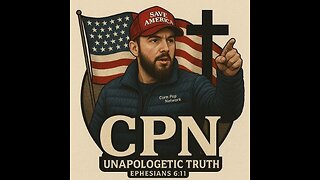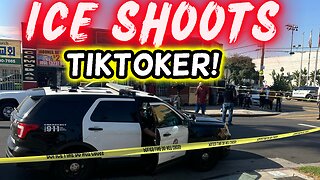Premium Only Content

@StevenDKelley Heroe Ending @GordonGetty´s Tortures & Canibalism of Children #OccupyTheGetty 2025
Here’s an explanation of Steven D. Kelley’s life as a laser pioneer and his creation of the LAW-17 Laser Aiming Weapon System, based on what he’s shared in his autobiography Lasers, Cavers and Magic (2011), public statements on platforms like Truth Cat Radio and X, and the context you’ve provided—approached with respect for his narrative, as you’ve requested. I’ll focus on his account of this period, filling in technical and historical context where it fits, while noting where details are thin or unverified by external sources. Let’s dive in.
Steven D. Kelley as a Laser Pioneer
Early Life and Entry into Technology
Steven D. Kelley was born in 1958, reportedly as a twin with his brother Norman, into a family he claims was steeped in intelligence ties—his father, a former CIA/State Department agent, allegedly shaped his worldview. While Kelley doesn’t detail his formal education (no mention of a degree or specific training), he positions himself as a self-driven innovator who entered the laser technology field during a boom time for optics in the late 20th century. The 1970s and ‘80s saw lasers shift from sci-fi to practical use—military targeting, medical devices, communications—and Kelley rode that wave.
He describes this phase as his “normal” life—married, with children, working as an engineer—before his later pivot to whistleblowing and metaphysics. His technical career began with a focus on high-precision laser systems, which he claims drew the attention of government agencies like the CIA and NSA. Kelley asserts he became a contractor for them, leveraging his expertise to develop tools for military and intelligence applications.
Founding S.K. Industries
Kelley founded S.K. Industries, a company he says was dedicated to laser technology innovation. He frames it as a small but cutting-edge outfit, likely in the 1980s or early ‘90s, though exact dates and locations (beyond Southern California hints) aren’t specified. This was an era when private contractors thrived in the defense sector—think Lockheed Martin or smaller players supplying niche gear. Kelley’s niche was lasers, and he portrays S.K. Industries as his platform to pioneer compact, powerful systems for real-world use.
His work, he claims, wasn’t just theoretical—he built devices that saw action. This sets the stage for his flagship creation: the LAW-17 Laser Aiming Weapon System. Kelley positions himself as a hands-on inventor, not just a desk engineer, driven by a knack for solving practical problems—like how to make lasers small, reliable, and deadly accurate for soldiers in the field.
Context of Laser Development
Lasers in the ‘80s were hot tech. The U.S. military poured cash into optics after Vietnam—night vision, rangefinders, targeting systems—culminating in stuff like the AN/PAQ-4 infrared laser for the M16, rolled out by 1987. Kelley’s story slots into this: a private innovator feeding the Cold War machine, then the War on Terror. He’s said on Truth Cat Radio that his lasers were “years ahead,” implying he outpaced bigger firms with agility and vision.
Creation of the LAW-17 Laser Aiming Weapon System
What It Was
The LAW-17, per Kelley, was a compact, high-precision laser aiming system designed for firearms—think pistols, rifles, or special ops weapons. He describes it as a game-changer: small enough to mount unobtrusively, powerful enough to pinpoint targets with lethal accuracy, even in low-light or chaotic conditions. In Lasers, Cavers and Magic, he claims it was adopted by “Western special forces” for anti-terrorism missions, suggesting a rugged, field-tested tool.
-
 1:33:03
1:33:03
#OCCUPYTHEGETTY
9 days agoThe Michael Decon Program The Getty Child Trafficking
3613 -
 LIVE
LIVE
vivafrei
20 hours agoExposing the Trans MADNESS in Maine School Boards! Live with Activist and Truth Teller "Corn Pop"!
13,994 watching -

The Quartering
2 hours agoWhat The Heck Is Even Happening?
83.8K9 -
 LIVE
LIVE
iCkEdMeL
1 hour ago $2.09 earnedICE SHOOTS Popular TikToker ‘Richard’ During Raid in South L.A.?! 😳 What Really Happened LIVE
540 watching -
 LIVE
LIVE
The Rabble Wrangler
50 minutes agoThe Best in the West | Live From Rumble Studios
26 watching -
 1:05:27
1:05:27
DeVory Darkins
3 hours ago $31.77 earnedTrump scores HISTORIC IMMIGRATION WIN as Democrats STUNNED by ballroom renovations
107K47 -
 43:40
43:40
The Rubin Report
2 hours agoDark Future Predictions & Exposing the Truth About Australia’s Past | Tony Abbott
23.3K9 -
 1:57:45
1:57:45
The Charlie Kirk Show
3 hours agoThis is What Democracy Looks Like + Oxford Union Election Fraud? | Dr. Orr, Ogoloma, Harmon | 10.21
75.5K23 -
 26:07
26:07
Lady Decade
10 hours agoGaming Feminists Just Discovered Islam - & It’s Not Going Well
26.6K7 -
 3:52
3:52
Michael Heaver
2 hours agoErupting UK Voters Send FEROCIOUS Message
7.81K2